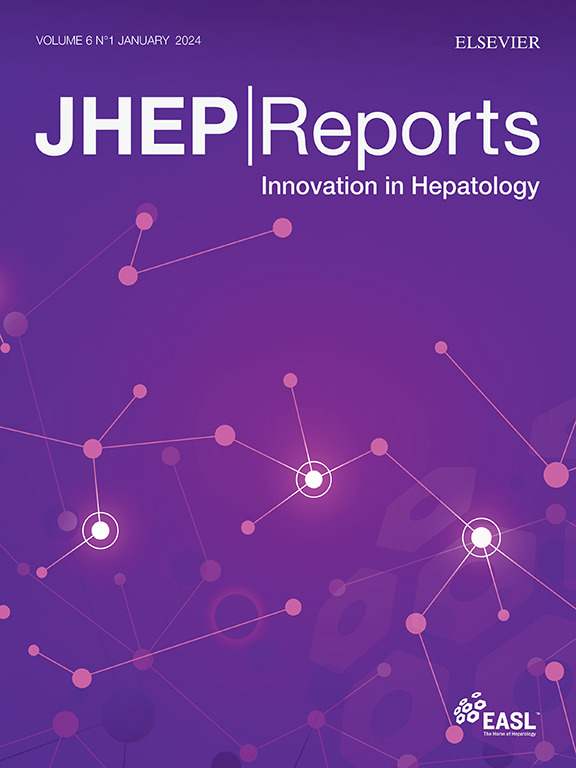严重的α -1抗胰蛋白酶缺乏与肝硬化首次失代偿后并发症的风险高于其他病因相关
IF 9.5
1区 医学
Q1 GASTROENTEROLOGY & HEPATOLOGY
引用次数: 0
摘要
背景,AimsAlpha-1抗胰蛋白酶缺乏症(AATD)导致/易患晚期慢性肝病。然而,SERPINA1 Pi * ZZ基因型在失代偿性肝硬化患者中的作用尚不清楚。因此,我们评估了Pi * ZZ基因型对第一次肝失代偿事件后疾病进程的影响。方法回顾性研究了来自12个欧洲三级保健中心的59例成人失代偿性肝硬化和严重AATD (Pi∗ZZ)。第一次失代偿被认为是基线。为了将AATD的病程与其他肝硬化病因进行比较,我们应用child - turcote - pugh (CTP)评分以及年龄/性别的倾向评分匹配。随访患者直至进一步失代偿、肝移植或肝相关死亡。结果患者以男性为主(74.6%),平均年龄55岁。第一次失代偿最常见的类型是腹水(n = 40;67.8%),其次是静脉曲张出血(n = 13;22.0%)和显性肝性脑病(n = 6;10.2%)。首次失代偿时CTP和MELD(终末期肝病模型)评分的中位数分别为8和14。MELD中位评分在肝移植和肝移植时分别为16分和20分(肝移植中位时间:2.9 [IQR 1.1-7.2]个月)。其他病因的患者(亚分布风险比:脂肪变性肝病:0.62,95% CI 0.44-0.88, p = 0.007;戒酒性酒精相关肝病:0.50,95% CI 0.35-0.71, p <0.001;丙型肝炎病毒相关肝硬化(0.56,95% CI 0.37-0.83, p = 0.004)与Pi * ZZ患者相比,进一步肝失代偿、肝移植或肝脏相关死亡的风险显著降低。将进一步失代偿与急性慢性肝功能衰竭交换也产生了类似的结果。结论:我们的研究确定了严重AATD (Pi * ZZ)患者失代偿性肝硬化的病程,这些患者特别容易出现肝硬化并发症,并且比其他病因的肝硬化患者表现出更大的病程进展。影响和意义α -1抗胰蛋白酶缺乏症是一种影响肺和肝的遗传性疾病。携带两个严重功能失调的α -1抗胰蛋白酶基因副本可能导致晚期慢性肝病/肝硬化。与患有类似晚期肝病的患者相比,患有肝硬化第一并发症的患者更容易发生进一步的肝脏相关事件(包括多器官功能障碍),并需要肝移植(可治愈遗传性肝病)。这些发现应该促进疾病改善治疗的发展和肝移植的早期上市。本文章由计算机程序翻译,如有差异,请以英文原文为准。
Severe alpha-1 antitrypsin deficiency is associated with a higher risk of complications after first decompensation than other aetiologies of cirrhosis
Background & Aims
Alpha-1 antitrypsin deficiency (AATD) causes/predisposes to advanced chronic liver disease. However, the role of the SERPINA1 Pi∗ZZ genotype in patients with decompensated cirrhosis is unclear. Thus, we evaluated the impact of the Pi∗ZZ genotype on the disease course after the first hepatic decompensation event.
Methods
We retrospectively included 59 adults with decompensated cirrhosis and severe AATD (Pi∗ZZ) from 12 European tertiary care centres. First decompensation was considered as baseline. To compare the course of AATD to other cirrhosis aetiologies, we applied propensity score matching for Child-Turcotte-Pugh (CTP) score as well as age/sex. Patients were followed until further decompensation, liver transplantation or liver-related death.
Results
Most patients were male (74.6%), with a mean age of 55 years. The most common type of first decompensation was ascites (n = 40; 67.8%), followed by variceal bleeding (n = 13; 22.0%) and overt hepatic encephalopathy (n = 6; 10.2%). Median CTP and MELD (model for end-stage liver disease) scores at first decompensation were 8 and 14, respectively. Median MELD scores were 16 and 20 points at listing and liver transplantation (median time on list: 2.9 [IQR 1.1-7.2] months), respectively. Patients with other aetiologies (subdistribution hazard ratio: steatotic liver disease: 0.62, 95% CI 0.44-0.88, p = 0.007; abstinent alcohol-associated liver disease: 0.50, 95% CI 0.35-0.71, p <0.001; hepatitis C virus-associated cirrhosis: 0.56, 95% CI 0.37-0.83, p = 0.004) had a significantly lower risk of further hepatic decompensation, liver transplantation, or liver-related death, compared to those with Pi∗ZZ. Exchanging further decompensation with acute-on-chronic liver failure yielded similar results.
Conclusion
Our study defines the course of decompensated cirrhosis in patients with severe AATD (Pi∗ZZ), who are particularly prone to complications of cirrhosis and exhibit a more progressive disease course than those with cirrhosis of other aetiologies.
Impact and implications
Alpha-1 antitrypsin deficiency is an inherited disease that affects the lung and the liver. Carrying two severely dysfunctional copies of the alpha-1 antitrypsin gene may cause advanced chronic liver disease/cirrhosis. Affected individuals with a first complication of cirrhosis are more prone to developing further liver-related events (including multiorgan dysfunction) and requiring liver transplantation (which cures the inherited liver disease) compared to patients who have similarly advanced liver disease. These findings should prompt the development of disease-modifying treatments and early listing for liver transplantation.
求助全文
通过发布文献求助,成功后即可免费获取论文全文。
去求助
来源期刊

JHEP Reports
GASTROENTEROLOGY & HEPATOLOGY-
CiteScore
12.40
自引率
2.40%
发文量
161
审稿时长
36 days
期刊介绍:
JHEP Reports is an open access journal that is affiliated with the European Association for the Study of the Liver (EASL). It serves as a companion journal to the highly respected Journal of Hepatology.
The primary objective of JHEP Reports is to publish original papers and reviews that contribute to the advancement of knowledge in the field of liver diseases. The journal covers a wide range of topics, including basic, translational, and clinical research. It also focuses on global issues in hepatology, with particular emphasis on areas such as clinical trials, novel diagnostics, precision medicine and therapeutics, cancer research, cellular and molecular studies, artificial intelligence, microbiome research, epidemiology, and cutting-edge technologies.
In summary, JHEP Reports is dedicated to promoting scientific discoveries and innovations in liver diseases through the publication of high-quality research papers and reviews covering various aspects of hepatology.
 求助内容:
求助内容: 应助结果提醒方式:
应助结果提醒方式:


